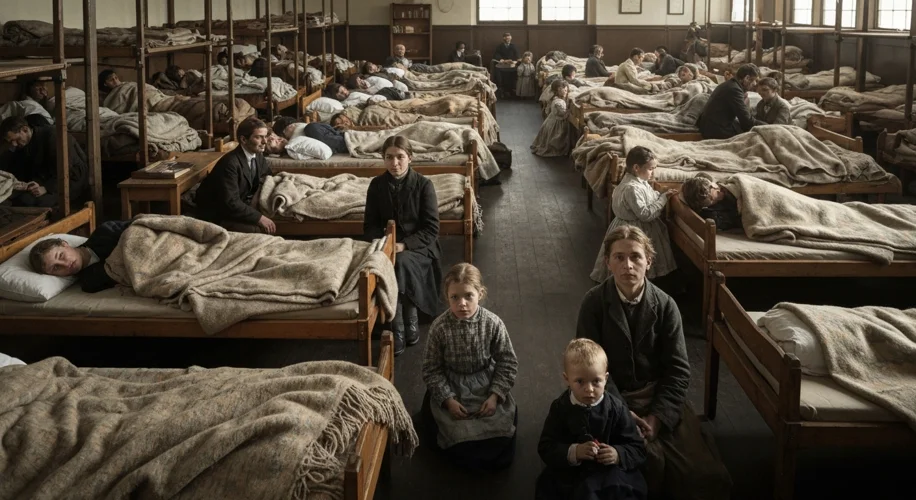The year is 1907. The air in the Narrows of New York Harbor is thick with salt spray and the mingled scents of coal smoke and anticipation. Below deck on the SS Hamburg, a young woman named Anya clutches a worn rosary, her knuckles white. Her gaze is fixed on the hazy outline of land emerging from the mist – the promise of America.
For millions like Anya, Ellis Island wasn’t just a processing center; it was the threshold to a new existence. It was a place of intense scrutiny, bewildering bureaucracy, and, for many, the first taste of a land where they hoped to build a life. The early 20th century witnessed an unprecedented wave of European immigration, with over 1 million souls arriving in 1907 alone. They came from bustling cities and quiet villages across Italy, Ireland, Poland, Russia, and countless other nations, each carrying a unique story of hardship, hope, and the courage to embark on a transatlantic voyage.
Anya’s journey had begun weeks earlier in a small village in Galicia, then part of the Austro-Hungarian Empire. Political unrest and economic hardship had made survival a daily struggle. Her family, like many others, had pooled their meager savings to secure her passage, pinning their hopes on her ability to find work and eventually send for them. The cramped, steerage conditions of the ship were a stark contrast to the dreams she held, but the shared resilience of her fellow passengers – the hushed conversations, the shared crusts of bread, the collective anxiety – forged a temporary community.
As the SS Hamburg docked, a cacophony of shouts in a dozen languages erupted. Anya, along with thousands of others, was herded onto the island. The Great Hall of Ellis Island, a vast, cavernous space, echoed with the sounds of a thousand anxious heartbeats. Officials in stiff uniforms moved with brisk efficiency, their faces impassive. Here, the meticulous process of inspection began. Anya’s eyes scanned the sea of faces, searching for any sign of familiarity, any hint of the welcome she’d been promised.

The initial medical examinations were swift and often intimidating. Doctors, using their black bags and specialized tools, looked for any sign of contagious diseases or physical ailments that might render an immigrant unfit for labor. Anya held her breath as a doctor examined her eyes, searching for the tell-tale signs of trachoma, a common affliction that could lead to immediate deportation. She passed, a wave of relief washing over her.
Next came the “6-second exam” – a cursory physical inspection. Immigrants were often instructed to walk, show their teeth, and even demonstrate their ability to work. Anya, despite her exhaustion, put her best foot forward, her mind racing with the questions she’d rehearsed: “Where are you going? Who will support you? Do you have a trade?”
The interrogation was the most crucial stage. Each immigrant faced a series of questions designed to assess their suitability for entry. They were asked about their destination, their intended occupation, their financial resources, and their political affiliations. Anya’s answers were practiced, her voice trembling slightly as she declared her intention to work as a seamstress in New York City and her destination: the tenement apartment of a distant cousin who had emigrated years before.
For those who passed these rigorous checks, the immediate challenge was securing accommodation. Many immigrants had pre-arranged lodgings through letters from relatives or the burgeoning immigrant aid societies. These provided a vital lifeline, offering a temporary roof over their heads and assistance in finding work. Anya’s cousin, a garment worker named Lena, had sent a detailed letter outlining directions and a small sum of money for her initial needs.
However, not everyone had such clear guidance. Some relied on the services offered by benevolent organizations like the Hebrew Immigrant Aid Society (HIAS) or the Catholic Immigrant Aid Society. These groups provided temporary shelter in hostels or dormitories, often within walking distance of Ellis Island or in the nearby boroughs of Manhattan and Brooklyn. These hostels, though basic, offered a crucial respite from the harshness of the voyage and the uncertainty of arrival.

The first few days in a new land were often a whirlwind of sensory overload. Anya arrived at Lena’s cramped Lower East Side apartment, a space already occupied by Lena’s family and two other recent arrivals. The air was thick with the aroma of simmering cabbage and garlic, a stark contrast to the bland ship rations, but a comforting scent of home nonetheless. The sounds of the city – the clatter of horse-drawn carts, the distant rumble of the elevated train, the incessant chatter of street vendors – were a constant, overwhelming symphony.
Finding immediate employment was paramount. For Anya, this meant navigating the labyrinthine streets to find a garment factory. She, along with many other newly arrived women, would join the queues outside factories, hoping for a chance to demonstrate their skills. The work was grueling, the hours long, and the pay meager, but it was work. It was the chance to earn money, to contribute to their families back home, and to take the first tentative steps toward self-sufficiency.
Navigating this new world required immense resilience. Learning a new language, understanding unfamiliar customs, and dealing with discrimination were daily challenges. Yet, the spirit of community often prevailed. Immigrants formed mutual aid societies, cultural clubs, and religious organizations that provided support, shared resources, and helped preserve their heritage. These nascent communities offered a vital sense of belonging in a vast, often indifferent, metropolis.

The experiences of immigrants like Anya at Ellis Island were varied and complex. While the island represented a gateway, it was also a point of profound vulnerability. The anxieties of potential rejection, the physical toll of the journey, and the overwhelming strangeness of a new culture combined to create an intensely emotional experience. Yet, it was within this crucible of challenge that the foundations of immigrant America were laid, a testament to the enduring human drive for a better life and the courage to find a new home, one uncertain step at a time.

